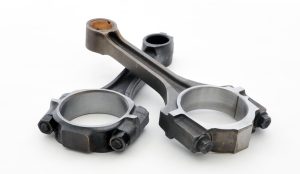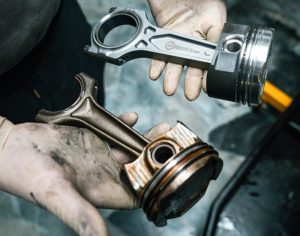The connecting rod is a crucial yet often overlooked component in an internal combustion engine. Despite its simple appearance, the connecting rod plays a vital role in converting the reciprocating motion of the piston into the rotary motion necessary to turn the crankshaft. Understanding how connecting rods work, the different types available, and the signs of wear can help you maintain engine performance and avoid costly repairs.
What is a Connecting Rod?

A connecting rod, commonly referred to as a “conrod,” is the mechanical link between the piston and the crankshaft. It transfers the force generated by the combustion of fuel inside the cylinder to the crankshaft, which ultimately powers the vehicle’s drivetrain.
Key Functions:
-
Transmit combustion forces from piston to crankshaft
-
Convert linear piston motion into rotational crankshaft motion
-
Maintain engine timing and mechanical integrity
Anatomy of a Connecting Rod
A typical connecting rod consists of three main parts:
| Part | Description |
|---|---|
| Small End | Connects to the piston via the piston pin (wrist pin) |
| Rod Body | The long, sturdy section that withstands compression and tension |
| Big End | Connects to the crankshaft journal with bearings |
Each of these parts must be precisely manufactured to handle intense stresses and maintain engine efficiency.
Types of Connecting Rods
There are several types of connecting rods, differentiated by their design, material, and manufacturing method.
1. I-Beam Connecting Rods
-
Description: Shaped like the letter “I” in cross-section.
-
Advantages: Lightweight yet strong; offers good resistance to bending.
-
Common Use: Standard OEM engines and performance applications.
2. H-Beam Connecting Rods
-
Description: Cross-section resembles the letter “H.”
-
Advantages: Heavier and stronger than I-beam; ideal for high-performance and heavy-duty engines.
-
Common Use: High-horsepower and racing engines.
3. Split Big-End Connecting Rods
-
Description: The big end is split into two parts for ease of assembly around the crankshaft.
-
Advantages: Easier to assemble and disassemble for maintenance.
-
Common Use: Most automotive engines.
4. Monolithic (One-Piece) Connecting Rods
-
Description: The big end is not split; used in some specialized applications.
-
Advantages: Increased strength; however, limited to certain engine designs.
-
Common Use: Rare in automotive engines.
Materials Used in Connecting Rods
The material choice affects strength, weight, and durability:
| Material | Characteristics | Common Applications |
|---|---|---|
| Steel | High strength, cost-effective, durable | Most passenger and commercial vehicles |
| Aluminum Alloy | Lightweight, less strength, prone to fatigue | Racing and high-performance engines |
| Titanium | Extremely strong, very lightweight, expensive | High-end racing and aerospace engines |
| Powdered Metal | Cost-effective, consistent properties | Mass-produced engines |
How Connecting Rods Work in the Engine Cycle
-
Intake Stroke: The piston moves down, drawing in the air-fuel mixture; the connecting rod transmits this motion smoothly.
-
Compression Stroke: The piston moves up, compressing the mixture; the rod withstands compressive forces.
-
Power Stroke: Combustion pushes the piston down; the connecting rod transfers this force to rotate the crankshaft.
-
Exhaust Stroke: The piston moves up again to expel exhaust gases.
Signs of Connecting Rod Wear or Failure
Connecting rods endure extreme conditions, and any failure can lead to catastrophic engine damage. Here are some common signs of wear or impending failure:
| Symptom | Possible Cause | Consequences |
|---|---|---|
| Knocking or tapping noises | Worn rod bearings or loose bolts | Engine damage, crankshaft wear |
| Low oil pressure | Bearing clearance increased due to wear | Insufficient lubrication, overheating |
| Excessive vibration | Bent or damaged rod | Reduced engine smoothness, possible breakage |
| Engine misfire or loss of power | Broken or cracked rod, piston not moving correctly | Severe engine damage, possible failure |
| Metal debris in oil | Rod bearing failure | Immediate engine repair needed |
Maintenance Tips for Connecting Rods

-
Regular Oil Changes: Proper lubrication prevents premature bearing wear.
-
Use Quality Bearings: Choose bearings designed for your engine type.
-
Monitor Oil Pressure: Low oil pressure can signal rod bearing problems.
-
Avoid Over-revving: Excessive RPMs strain rods beyond their limits.
-
Engine Inspection: If knocking noises arise, inspect rod bearings promptly.
Connecting Rod Replacement and Cost Considerations
Replacing connecting rods is a major engine repair typically done during engine rebuilds or upgrades. Costs depend on:
| Factor | Typical Range |
|---|---|
| Connecting Rod Set Cost | $150 – $1000+ depending on material and brand |
| Labor | $500 – $1500 depending on engine type and complexity |
| Associated Parts | Bearings, piston pins, gaskets |
Always consult a trusted mechanic or technician to assess whether replacement is necessary.
Summary Table: Connecting Rod Types, Advantages, and Uses
| Type | Material | Advantages | Best For |
|---|---|---|---|
| I-Beam | Steel/Aluminum | Lightweight, strong | Stock and moderate performance |
| H-Beam | Steel/Titanium | High strength, durability | High-performance/racing |
| Split Big-End | Steel | Easy assembly, maintenance | Most passenger vehicles |
| Monolithic | Steel/Titanium | Maximum strength | Specialized racing engines |
Final Thoughts
Understanding the role of connecting rods in your engine can help you appreciate their importance and identify potential problems early. Proper maintenance and timely replacement of worn rods or bearings can save you from costly engine damage and maintain your vehicle’s performance.
For reliable, high-quality replacement parts, consider exploring options to Buy Connecting Rods online. Choosing the right connecting rods tailored to your vehicle and driving style ensures long-term engine durability and optimal performance.